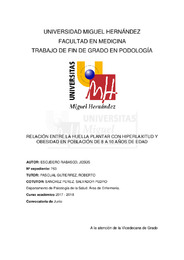Por favor, use este identificador para citar o enlazar este ítem:
https://hdl.handle.net/11000/25929Registro completo de metadatos
| Campo DC | Valor | Lengua/Idioma |
|---|---|---|
| dc.contributor.advisor | Pascual Gutiérrez, Roberto | - |
| dc.contributor.author | Escudero Rabasco, Jesús | - |
| dc.contributor.other | Departamentos de la UMH::Psicología de la Salud | es_ES |
| dc.date.accessioned | 2022-02-22T08:17:18Z | - |
| dc.date.available | 2022-02-22T08:17:18Z | - |
| dc.date.created | 2018-06-20 | - |
| dc.identifier.uri | http://hdl.handle.net/11000/25929 | - |
| dc.description.abstract | Introducción: La obesidad y la hiperlaxitud se han convertido problemas de cierta magnitud que pueden acarrear consecuencias durante la edad adulta. Diversos autores sugieren la relación de estas dos entidades con el padecimiento de pies planos. Objetivos: Establecer la relación entre pies plano, obesidad e hiperlaxitud. Material y métodos: Estudio de campo con niños de 8 a 10 años de edad. La muestra consta de 84 alumnos (36 niñas y 48 niños). Se determinó el Foot Posture Index, el Índice de Chippaux, Test de Beigthon para la hiperlaxitud e Índice de Masa Corporal. Resultados y discusión: Encontramos que existe relación entre el sobrepeso/obesidad y pies pronados/huella plana. En relación al IMC 38 alumnos (45.2%) presenta un IMC normal y 46 (54.8%) tienen sobrepeso y obesidad. En relación al FPI en el pie derecho, 55 sujetos tienen un FPI pronado o altamente pronado (65%), mientras que en pie izquierdo, 50 sujetos tienen un FPI pronado (60%) o altamente pronado. En relación el Índice de Chippaux 42 sujetos (50%) tienen la huella plana tanto en el pie derecho como en el izquierdo. Según el Índice de Chippaux tenemos un 6% más de riesgo de padecer pie plano y mediante el FPI un 16-21% más. Según el test de Beigthon, de los 84 niños revisados, 10 (11.9%) alumnos tienen hiperlaxitud sin relación alguna con pies pronados o huella plana. Conclusiones: Hemos encontrado que los niños con sobrepeso/obesidad tienen más pies pronados y huellas planas que los normopeso determinado por Índice de Chippaux y por FPI. No encontramos relación entre hiperlaxitud y pie plano aunque todos los hiperlaxos tenían pie pronado y huella plana. | es_ES |
| dc.description.abstract | Introduction: Obesity and hypermobility have become problems of a certain magnitude that can have consequences during adulthood. Several authors suggest the relationship of these two entities with the condition of flat feet. Objectives: Establish the relationship between flat feet, obesity and hyperlaxity. Material and methods: Field study with children from 8 to 10 years old. The sample consists of 84 students (36 girls and 48 boys). The Foot Posture Index, the Chippaux Index, Beigthon Test for hyperlaxity and Body Mass Index were determined. Results and discussion: We found that there is a relationship between overweight / obesity and pronged feet / flat footprint. In relation to the BMI, 38 students (45.2%) presented a normal BMI and 46 (54.8%) were overweight and obese. In relation to the IPF in the right foot, 55 subjects have a PRF or highly-prone IPF (65%), while in the left foot, 50 subjects have a PRI (60%) or a highly PRF. In relation to the Chippaux Index, 42 subjects (50%) have a flat footprint on both the right and the left foot. According to the Chippaux Index we have a 6% higher risk of suffering from flat feet and through the FPI a 16-21% more. According to the Beigthon test, of the 84 children reviewed, 10 (11.9%) students have hypermobility without any relation to a pronated or flat footprint. Conclusion: We have found that overweight / obese children have more flat feet and flat footprints than normal weight determined by the Chippaux Index and by FPI. We did not find a relationship between hyperlaxity and flat foot although all the hyperlaxos had a pronged foot and a flat footprint. | es_ES |
| dc.format | application/pdf | es_ES |
| dc.format.extent | 36 | es_ES |
| dc.language.iso | spa | es_ES |
| dc.publisher | Universidad Miguel Hernández | es_ES |
| dc.rights | info:eu-repo/semantics/openAccess | es_ES |
| dc.rights | Attribution-NonCommercial-NoDerivatives 4.0 Internacional | * |
| dc.rights.uri | http://creativecommons.org/licenses/by-nc-nd/4.0/ | * |
| dc.subject | obesidad infantil | es_ES |
| dc.subject | pie plano | es_ES |
| dc.subject | hiperlaxitud | es_ES |
| dc.subject | índice de Chippaux | es_ES |
| dc.subject | foot posture index | es_ES |
| dc.subject.other | CDU::6 - Ciencias aplicadas | es_ES |
| dc.title | Relación entre la huella plantar con hiperlaxitud y obesidad en población de 8 a 10 años de edad | es_ES |
| dc.type | info:eu-repo/semantics/bachelorThesis | es_ES |

Ver/Abrir:
763_ESCUDERO_RABASCO_JESÚS.pdf
1,13 MB
Adobe PDF
Compartir:
 La licencia se describe como: Atribución-NonComercial-NoDerivada 4.0 Internacional.
La licencia se describe como: Atribución-NonComercial-NoDerivada 4.0 Internacional.
.png)